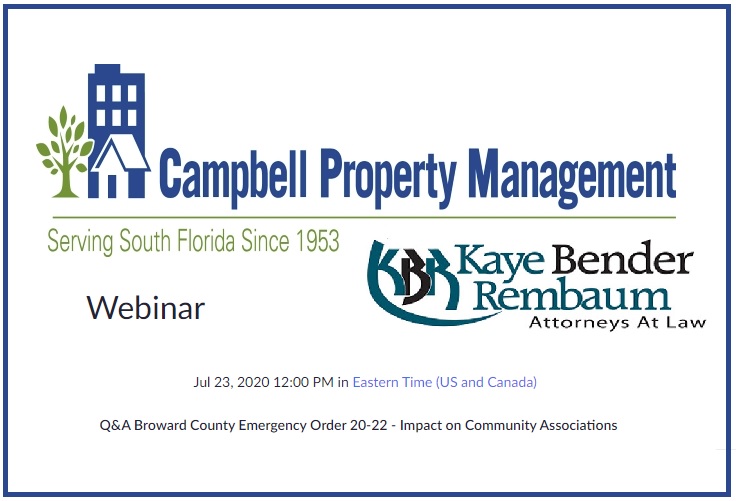MORE ABOUT COLLECTIONS By Eric Glazer, Esq. Published August 3, 2020
MORE ABOUT COLLECTIONS
By Eric Glazer, Esq.
Published August 3, 2020
As promised a few weeks back, we need to discuss some very interesting pitfalls associations sometimes fall into in the area of collections. In light of the fact that mortgage delinquencies are at an all-time high, rest assured that owners will in a short while begin falling behind on condo and HOA assessments as well.
The association must accept even partial payments.
Suppose the assessments are $300.00 per month. An owner has not paid in 3 months and owes $900.00 plus late fees and interest. The owner sends in a payment for $300.00. Must the association accept the $300.00 payment? YES.
In Ocean Two Condominium Ass’n, Inc. v. Kliger, 983 So.2d 739 (Fla.App. 3 Dist.,2008) the court held that the refusal of a condominium association and its management company of tendered payments of undisputed maintenance fees by condominium unit owners was improper and rendered premature the association’s lien foreclosure action involving owners’ units.. The condominium statute provided that such payments were to be applied on account, without prejudice to association’s and unit owners’ respective positions. In this case, the dispute would have been reduced to an inconsequential amount, and association’s attorneys could not in good faith have filed to foreclose the miniscule claim remaining. West’s F.S.A. § 718.116(3).
The association should not worry about restrictive endorsements.
Same scenario as above, but this time, the owner writes “paid in full” on the $300.00 check. Should the association deposit the check? If they do, are they now prevented from suing for the $600.00 balance?
The condo and HOA statutes each provide the methods by which to apply assessments that are paid. Each statute makes it clear that they are to be applied in accordance with the statute, and any purported accord and satisfaction, or any restrictive endorsement, designation, or instruction placed on or accompanying a payment. In simple terms, after applying the payment, the balance is still owed despite the words “paid in full” or similar words being placed on the check.
The association must apply the monies in accordance with the statute.
Same scenario as above, but the owner has also incurred $200.00 in attorney’s fees, $10.00 in interest and $75.00 in late fees. How much does the owner owe to the association after making the $300.00 payment?
The statute says……….Assessments and installments on assessments which are not paid when due bear interest at the rate provided in the declaration, from the due date until paid. The rate may not exceed the rate allowed by law, and, if no rate is provided in the declaration, interest accrues at the rate of 18 percent per year. If provided by the declaration or bylaws, the association may, in addition to such interest, charge an administrative late fee of up to the greater of $25 or 5 percent of each delinquent installment for which the payment is late. Any payment received by an association must be applied first to any interest accrued by the association, then to any administrative late fee, then to any costs and reasonable attorney fees incurred in collection, and then to the delinquent assessment.
About HOA & Condo Blog
Since 2009, Eric has been the host of Condo Craze and HOAs, a weekly one hour radio show that airs at noon each Sunday on 850 WFTL.Eric Glazer graduated from the University of Miami School of Law in 1992 after receiving a B.A. from NYU. He has practiced community association law for more than 2 decades and is the owner of Glazer and Sachs, P.A. a seven attorney law firm with offices in Fort Lauderdale and Orlando and satellite offices in Naples, Fort Myers and Tampa.
See: www.condocrazeandhoas.com.
He is the first attorney in the State of Florida that designed a course that certifies condominium residents as eligible to serve on a condominium Board of Directors and has now certified more than 10,000 Floridians all across the state. He is certified as a Circuit Court Mediator by The Florida Supreme Court and has mediated dozens of disputes between associations and unit owners. Eric also devotes significant time to advancing legislation in the best interest of Florida community association members.
Tags: Condo and HOA Accounting, Condo and HOA Collections, Condo and HOA Laws, Management News




 For starters, lets differentiate between “paint” and “coating”. All coatings are paints, but not all paints are coatings. Generally speaking, paint is used for aesthetics, and coatings are used for performance. Coatings are paints that serve a purpose beyond just the aesthetic color and finish. In addition to color and texture, coatings can provide waterproofing, elasticity, breathability, dirt shedding and corrosion prevention properties. With these additional properties typically comes added cost. As such, it is important to make sure you are selecting the correct coating with proper preparation and application techniques to get the best long-lasting performance and return on your investment.
For starters, lets differentiate between “paint” and “coating”. All coatings are paints, but not all paints are coatings. Generally speaking, paint is used for aesthetics, and coatings are used for performance. Coatings are paints that serve a purpose beyond just the aesthetic color and finish. In addition to color and texture, coatings can provide waterproofing, elasticity, breathability, dirt shedding and corrosion prevention properties. With these additional properties typically comes added cost. As such, it is important to make sure you are selecting the correct coating with proper preparation and application techniques to get the best long-lasting performance and return on your investment.










 If your commercial property sustains enough damage in a short enough time to cause you to consider shuttering the doors, you have an emergency repair. This could mean:
If your commercial property sustains enough damage in a short enough time to cause you to consider shuttering the doors, you have an emergency repair. This could mean: COVID-19 has reshaped the way that we approach many aspects of our lives, and in many cases, has redetermined how we view and manage our spaces, homes and properties. Given the increased attention to how a virus can spread through contact and surfaces, in the reopening process real estate professionals and property managers will have to determine how to ensure that properties are safe so that the virus cannot be easily spread. Below, we’ll discuss how managing properties will change after lockdown ends and we all begin to assimilate to a new sense of normalcy.
COVID-19 has reshaped the way that we approach many aspects of our lives, and in many cases, has redetermined how we view and manage our spaces, homes and properties. Given the increased attention to how a virus can spread through contact and surfaces, in the reopening process real estate professionals and property managers will have to determine how to ensure that properties are safe so that the virus cannot be easily spread. Below, we’ll discuss how managing properties will change after lockdown ends and we all begin to assimilate to a new sense of normalcy.